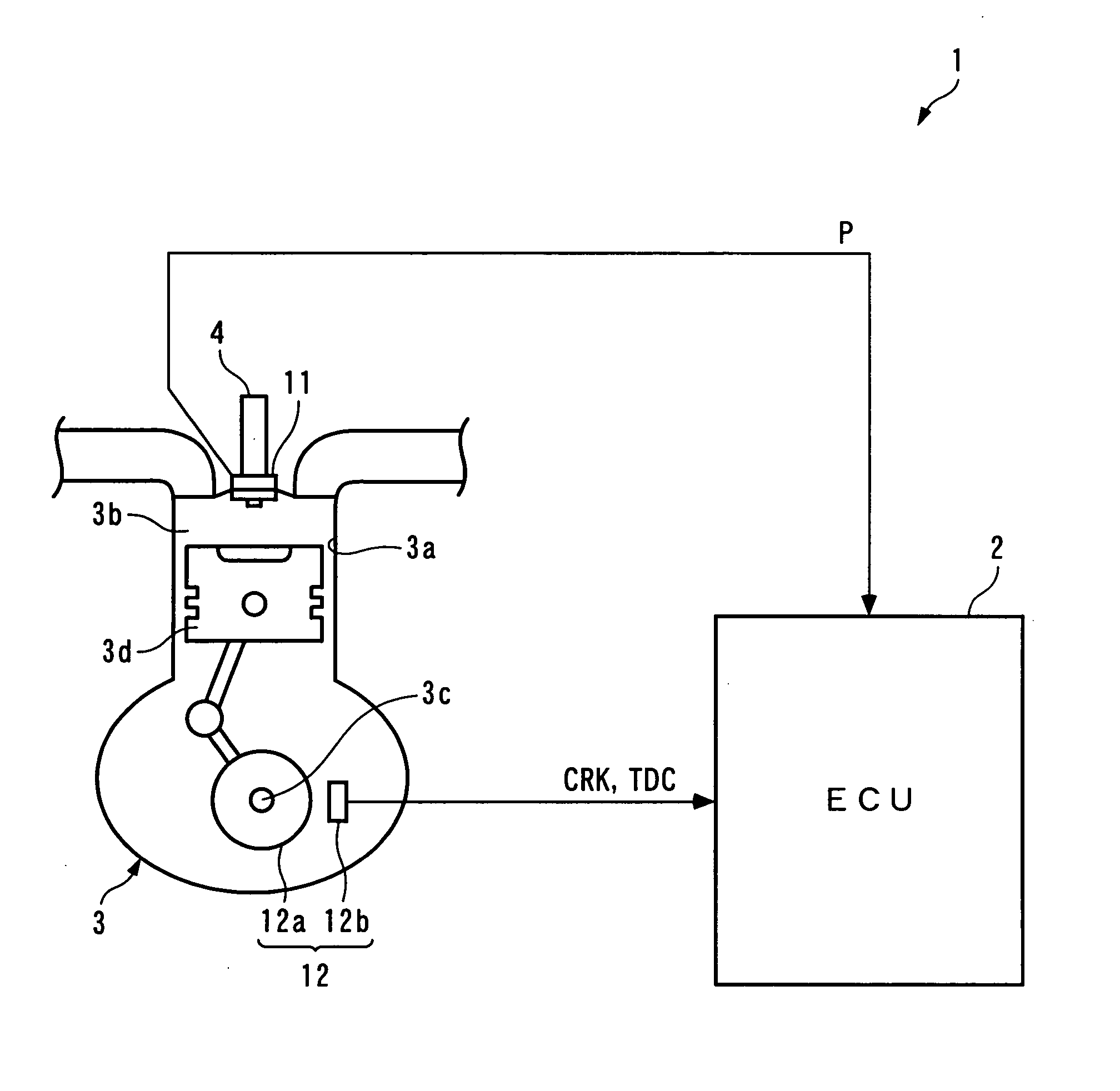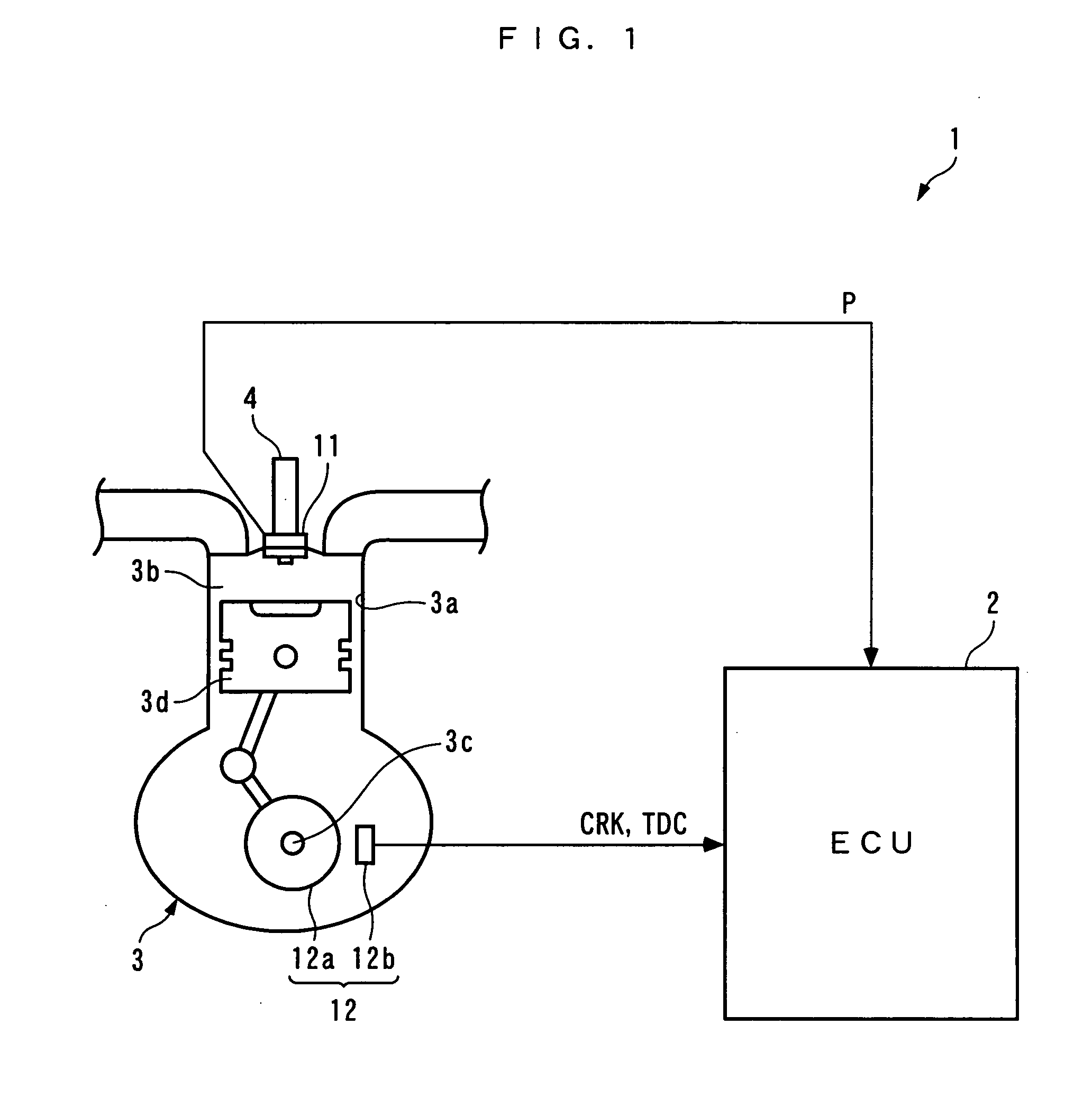[0013] With the configuration of the method according to the first aspect of present invention, pressure in the combustion chamber is detected to obtain in-cylinder-
pressure data indicative of the obtained pressure, and volume data indicative of a state of change in the volume of the combustion chamber is subjected to a first predetermined filtering process. Then, a work amount parameter is calculated based on the volume data subjected to the first filtering process and the in-cylinder
pressure data. Therefore, when a phase delay of the in-cylinder
pressure data is generated e.g. due to a filtering process for eliminating noises from the in-cylinder pressure data or the
response delay of a sensor that detects the in-cylinder pressure, the
relative phase deviation between the in-cylinder pressure data and the volume data can be eliminated e.g. by imparting the same phase delay as the phase delay of the in-cylinder pressure data to the volume data through the first filtering process. This makes it possible to calculate the work amount parameter with accuracy while properly compensating for the phase delay of the in-cylinder pressure data.
[0018] With the configuration of the method according to the second aspect of the present invention, in-cylinder pressure is-detected to obtain in-cylinder pressure data indicative of the detected pressure, and a predetermined reference signal is subjected to a first predetermined filtering process. Then, a work amount parameter is calculated based on the reference signal subjected to the first filtering process and the in-cylinder pressure data. Therefore, when a phase delay of the in-cylinder pressure data is generated e.g. by a filtering process performed thereon, the
relative phase deviation between the in-cylinder pressure data and the reference signal can be eliminated e.g. by imparting the same phase delay as the phase delay of the in-cylinder pressure data to the reference signal through the first filtering process. This makes it possible to calculate the work amount parameter with accuracy while properly compensating for the phase delay of the in-cylinder pressure data.
[0020] With the configuration of the preferred embodiment, a
correlation coefficient between the in-cylinder pressure data and the reference signal is calculated based on the in-cylinder pressure data and the reference signal subjected to the first filtering process, and the work amount parameter is calculated based on the calculated
correlation coefficient. As a result, when a phase delay of the in-cylinder pressure data is generated, the
relative phase deviation between the-in-cylinder pressure data and the reference signal can be eliminated e.g. by imparting the same phase delay as the phase delay of the in-cylinder pressure data to the reference signal through the first filtering process. This makes it possible to properly calculate the
correlation coefficient while properly compensating for the phase delay of the in-cylinder pressure data, and hence the work amount parameter can be calculated with accuracy.
[0024] In contrast, according to the present invention, the in-cylinder pressure data is subjected to the second filtering process before it is sampled at the second repetition period. In this case, for example, the second filtering process is performed to eliminate components of the in-cylinder pressure data in a frequency range (hereinafter referred to as “the predetermined frequency range”) not lower than the half of a frequency corresponding to the second repetition period, whereby the components in the predetermined frequency range are eliminated in advance before sampling of the in-cylinder pressure data. As a result, even if the in-cylinder pressure data is sampled at the second repetition period longer than the first repetition period, which can cause
aliasing, it is possible to prevent
aliasing from being caused by the sampling, thereby making it possible to prevent
distortion of the in-cylinder pressure caused by the
aliasing.
[0025] Further, the phase delay of the in-cylinder pressure data caused by the second filtering process can be properly compensated for e.g. by performing the first filtering process using a filter having the same characteristic as that of a filter used in the second filtering process to thereby impart the same phase delay as the phase delay of the in-cylinder pressure data to the volume data or the reference signal to thereby eliminate the relative
phase deviation between the in-cylinder pressure data and the volume data or the reference signal. This makes it possible to calculate the work amount parameter with accuracy while preventing aliasing and properly compensating for the phase delay of the in-cylinder pressure data. It should be noted that although in the second filtering process, the components of the in-cylinder pressure data in the frequency range not lower than the half of the frequency corresponding to the second repetition period are eliminated, as described above, components of the in-cylinder pressure data in a frequency range not lower than a predetermined frequency higher than the half of the frequency corresponding to the second repetition period may be eliminated so long as the result of calculation of the work amount parameter is not affected by aliasing. Furthermore, the in-cylinder pressure data sampled at the second repetition period longer than the first repetition period is used for calculation of the work amount parameter, which makes it possible to reduce the number of data items necessary for the calculation, which contributes to
thinning of the data. Therefore, it is possible to decrease computation load of the work amount parameter.
 Login to View More
Login to View More  Login to View More
Login to View More 


